
Deoksugung Palace Entrance Fee, Stonewall Walkway
In my experience, Deoksugung Palace is a charming, less crowded palace. It dates back to the Korean Empire era. Only two free English guided tours are available each day at both Deoksugung and Seokjojeon. Make sure you check the entrance fee and opening hours before you plan your visit. If you love K-dramas, you'll appreciate the Stonewall Walkway there as well.
Deoksugung Palace History
In 1895, after the tragic assassination of Empress Myeongseong by Japan, King Gojong sought refuge at the Russian Legation. He returned to Deoksugung Palace (덕수궁) in 1897.
When he returned, he changed the name of the country, from Joseon to Daehan, and established the Daehan Empire. South Korea's official name is "Daehanminguk" (대한민국) in Korean. While it's called "Republic of Korea" in English, it's called "Daehanminguk" in Korean.


Emperor Gojong
In 1905, Japan forced Korea to sign the Eulsa Treaty against its will, effectively removing Korea's ability to manage its own diplomatic affairs.
A second peace conference was held in The Hague, Netherlands in 1907. Emperor Gojong secretly sent messengers to show that the Eulsa Treaty was unfair because Japan had forced it upon Korea. Sadly, the big powerful countries did not want to help, and Japan learned too.
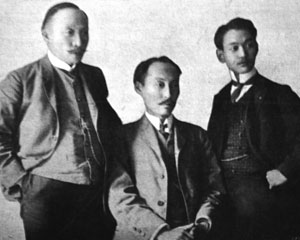
The Hague Secret Emissary Affair
As a result, Japan pushed Emperor Gojong to step down from being emperor and let his son, Sunjong, take over. In 1907, when Sunjong became emperor, he moved to Changdeokgung Palace. In 1919, Gojong passed away at the age of 66 in the Hamnyeongjeon at Deoksugung Palace.
If you are curious about the final days of Emperor Sunjong, visit Changdeokgung Palace. He and his family spent their remaining years here.
✅ Free English Guided Tour
Free English guided tours are available at Deoksugung Palace from Tuesday through Sunday. It is possible to join these tours at 10:45 AM and 1:30 PM, and they usually last about 40 minutes. You can see a sign on your left as you enter through the main gate, called Daehanmun.
Deoksugung Palace Seokjojeon and Modernization
In Deoksugung Palace, you'll find two prominent Western-style buildings. The one on the left is now used as the National Museum of Modern and Contemporary Art, and it was built in 1937 during the Japanese colonial period.
For Emperor Gojong of the Korean Empire, the other one was built in 1909 as his office and a meeting place for diplomats from abroad. Reflecting Koreans' modernization enthusiasm, it was constructed in a Western style.

When I first saw Seokjojeon, I was amazed. It's not something you see often in Korea, especially in a place like this palace. When I learned more about why it was built, I felt a mix of emotions. At the time, Korea was isolated from the rest of the world and focused on just surviving. The main goal was to protect the country from stronger nations, and discussions about ideas or principles were put on hold. So, I saw Seokjojeon as a message to the world: "We can do it too. We can change like you. We can be like you."
In the Korean Empire era, Korea quickly modernized. Electric companies and power plants were established, bringing electricity and telephones to the country. Streetlights lit up the streets at night. You can see this exciting period in the Netflix show 'Mr. Sunshine,' in which people are amazed by the new electric lights.
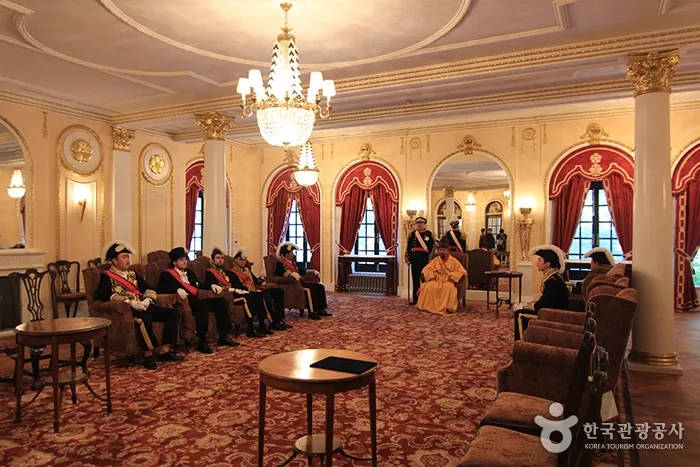
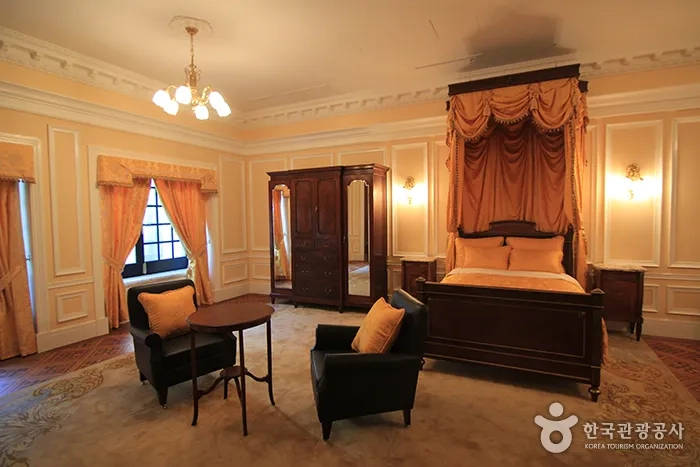
On the left, a reenactment of "Foreign Diplomatic Encounters with the Emperor," and on the right, the Emperor's bedroom.
When it comes to food, Western culture left a lasting mark. Western-style restaurants started popping up, and Koreans began to enjoy Western dishes. Emperor Gojong took it further by opening a cafe within the palace, the Jeonggwanheon (정관헌), where he enjoyed coffee, tea, and delicious desserts.
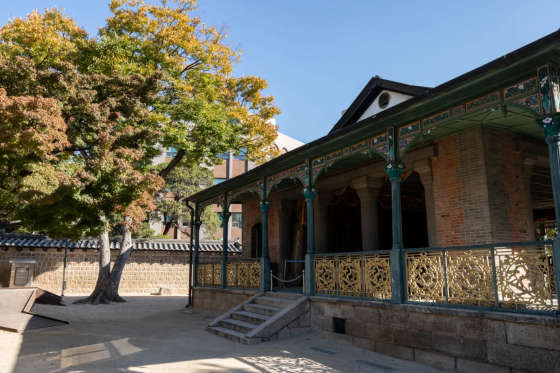
Jeonggwanheon
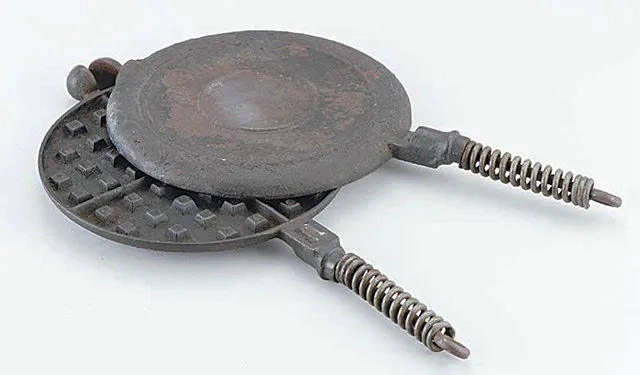
Waffle Pan Used in the Royal Court
© National Palace Museum of Korea
✅ Free Guided English Tour of the Daehan Empire History Museum
Currently, Seokjojeon serves as the Daehan Empire History Museum. Entry is free, but you must join a guide for the tour. Tours last around 40 minutes each at 11:50 AM and 2:50 PM. At the Seokjojeon Daehan Empire History Museum Information Desk, reservations can be made on-site, on a first-come, first-served basis. There is a maximum group reservation limit of 20 people.
The symbol of the Korean Empire
🟡 Plum blossoms

Plum blossoms were chosen as the symbol of the Korean Empire because the Chinese character for this flower, 이화 (李花), contains the character "이" (李), which is the same character found in the surnames of kings and emperors. On pillars, benches, and even floor drains in the Deoksugung complex, you can find plum blossom designs. I personally enjoyed hunting for them.
🟡 Golden color
There is a depiction of Emperor Gojong wearing a gold dragon robe in the Korean drama 'Mr. Sunshine,' and the interior of Seokjojeon, where the Emperor lived and worked, was adorned in gold, establishing it as the emblematic color of the Korean Empire.
An Emperor Gojong portrait in a gold dragon robe can be found at the National Palace Museum of Korea, located just next to Gyeongbokgung Palace. In addition, you can see Emperor Sunjong's and the Empress's car, which features plum blossom patterns and gold seats.
Deoksugung Palace Stonewall Walkway
There are many trees that line the Deoksugung Palace Stonewall Walkway, making it a famous 900-meter walk with ever-changing scenery with each season. A lush greenery surrounds you during the summer and spring, while vibrant yellow leaves cover the path during the autumn.
Although it is a delightful route for a leisurely stroll and has even been featured in a few Korean dramas, including "Goblin," there is a local myth that walking it with your partner might cause a breakup.
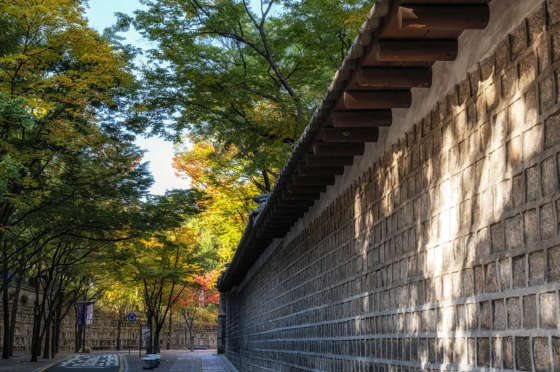
Several stories are associated with this myth, including one that divorced couples had to walk along the Deoksugung Stonewall Walkway when the family court was located in Jongno, contributing to the myth.
In another story, students from Paichai School and Ewha School are mentioned. In the Korean Empire, both schools are situated near the Deoksugung Stonewall Walkway. In the story, young couples in love take a walk along this path before parting ways to attend their respective schools.
Deoksugung Palace Location, Subway Station
How to go to Deoksugung Palace?
- Address: 99 Sejong-daero, Jung-gu, Seoul
- Subway Station: Subway Line 1, City Hall Station, Exit 1 or 2 OR Subway Line 2, City Hall Station, Exit 12
- Website: 🔗 Deoksugung Palace
Deoksugung Palace Entrance Fee, Opening Hours
⛔ Closed on Mondays ❗ Deoksugung Palace is closed every Monday.
| days | Opening Hours | Last Entry |
|---|---|---|
| Tuesday - Sunday | 9 AM to 9 PM | 8 PM |
- If the palace closure date falls on a public holiday (including compensatory holidays), the palace will be open. In this case, the first non-public holiday after the open holiday becomes the new closure date.
🟡 Royal guard ceremonies take place daily at 11 AM and 2 PM, except on Mondays, at the main gate (Daehanmun). Lasting around 10 minutes, these brief yet enjoyable spectacles feature musical performances.
🟡 Entrance Fee:
| Age | KRW |
|---|---|
| Children (0-6) | Free |
| Children (7-18) | 500 |
| Adults (19-64) | 1,000 |
| Adults (65 and above) | Free |
- ✔️ Visitors wearing hanbok can enter for free.
- ✔️ Every last Wednesday of the month is Culture Day, and you can enter for free.
Wrap-up
Deoksugung Palace has a interesting history, especially Seokjojeon. It played a role in Korea's modernization. The emperor worked hard to protect the country while enjoying coffee and waffles! The palace is close to City Hall subway station, so if the entry fee and hours work for you, it's worth a visit.